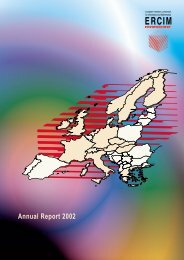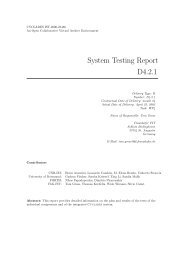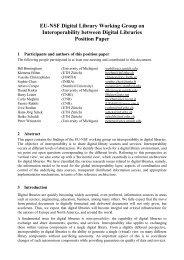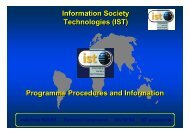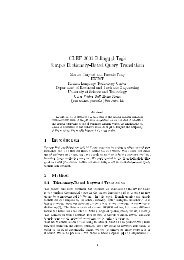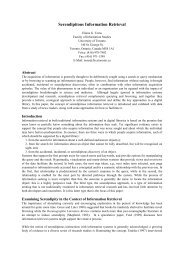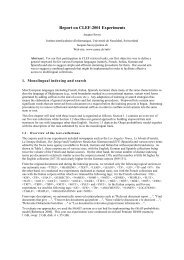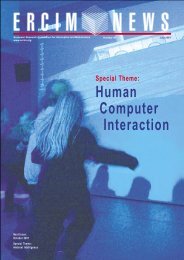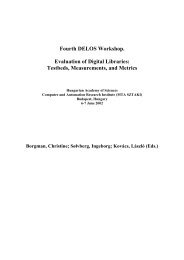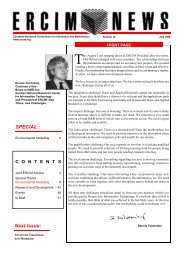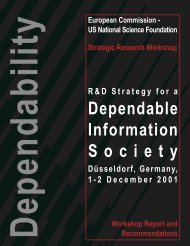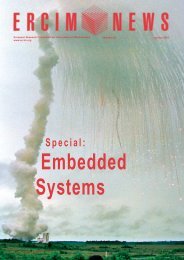Towards a Platform for Widespread Embedded Intelligence - ERCIM
Towards a Platform for Widespread Embedded Intelligence - ERCIM
Towards a Platform for Widespread Embedded Intelligence - ERCIM
Create successful ePaper yourself
Turn your PDF publications into a flip-book with our unique Google optimized e-Paper software.
The devices in the ad-hoc network running<br />
HyMN organise themselves in<br />
clusters, where the clusterheads act as<br />
injection points. For each group, interest<br />
in certain football matches is registered<br />
with the injection point. The injection<br />
point maintains an uplink to the backbone<br />
network in order to receive multimedia<br />
news related to the interests of the<br />
ad-hoc members. Thus, the football fans<br />
will receive injected in<strong>for</strong>mation such as<br />
small videos, pictures or text messages<br />
each time something interesting is happening<br />
during the match. The multimedia<br />
files received remain stored on<br />
the mobile devices and will be provided<br />
to further devices joining the interest<br />
group later on.<br />
In order to optimise the injection process,<br />
the backbone multimedia files are<br />
split into chunks. These chunks are<br />
injected concurrently to different injec-<br />
Visualization<br />
Visualization of Colour In<strong>for</strong>mation<br />
on Highly Detailed 3D Models<br />
by Matteo Dellepiane and Marco Callieri<br />
tion points within a single ad-hoc network<br />
partition. Thus, the bandwidth <strong>for</strong><br />
injecting data into a single partition is<br />
increased and the files reach the ad-hoc<br />
network faster. After reaching the network,<br />
the chunks are exchanged among<br />
the interested devices until all devices<br />
receive the complete file.<br />
To realise the architecture presented, we<br />
focus on mobile devices establishing<br />
clusters in a self-organising way. For<br />
this, we have developed a clustering<br />
algorithm - namely WACA - that<br />
employs a heuristic weight function. The<br />
WACA algorithm (Weighted<br />
Application aware Clustering<br />
Algorithm) is designed to build an adhoc<br />
network topology that fits the needs<br />
of the application running on top of it. To<br />
achieve this, several parameters can be<br />
set in the weight function. The HyMN<br />
application focuses on multimedia con-<br />
It is now possible to display very detailed colour in<strong>for</strong>mation on big 3D models.<br />
Research at the Visual Computing Lab, ISTI-CNR, Pisa, Italy, aims at creating a<br />
mostly automatic, easy-to-use way of mapping colour on geometric data.<br />
The evolution of technology and important<br />
advances in the field of visualization<br />
of huge 3D datasets mean that it is now<br />
possible to acquire and display detailed<br />
3D models. However, in order to achieve<br />
a completely realistic result, high quality<br />
colour in<strong>for</strong>mation must be added to the<br />
geometric structure.<br />
A coloured model can be created starting<br />
from: a 3D dataset, a set of photos (such<br />
as those shown in Figure 1) and calibration<br />
data, ie, the values of the parameters<br />
of the camera that took the photos. They<br />
can be divided into two groups: extrinsic<br />
parameters (translation vector and rotation<br />
matrix), related to the position of the<br />
camera in the space, and intrinsic parameters,<br />
the 'internal' settings (focal length,<br />
lens distortion) of the camera.<br />
Un<strong>for</strong>tunately, in most cases, calibration<br />
data are not available and have to be estimated.<br />
Camera parameters are calculated by<br />
aligning each photo to the model: since<br />
this can only be done automatically in<br />
particular cases (eg, 'shape from silhouette'),<br />
user intervention is necessary.<br />
Algorithms which align a photo on a<br />
model need some correspondences<br />
between them: the user must indicate<br />
some corresponding points on both<br />
objects.<br />
Our software, called TexAlign, allows<br />
users to load both the model and all the<br />
photos, creating an Alignment Process<br />
whose data (correspondences coordinates,<br />
parameters of aligned images) are<br />
saved in an xml file. It is also possible to<br />
R&D AND TECHNOLOGY TRANSFER<br />
tent distribution from a backbone network<br />
to ad-hoc networks. To optimise<br />
this process, parameters like signal<br />
strength to the backbone network, long<br />
battery lifetime, dissemination degree<br />
and clustering coefficient are used <strong>for</strong><br />
clusterhead election.<br />
On-going research focuses on investigating<br />
how the mobile devices deal with<br />
different mobility scenarios. The HyMN<br />
system will be further developed and a<br />
middleware <strong>for</strong> wireless hybrid network<br />
devices will be developed from it.<br />
Link:<br />
http://mocca.uni.lu<br />
http://syssoft.uni-trier.de/jane<br />
Please contact:<br />
Steffen Rothkugel,<br />
University of Luxembourg<br />
Tel: +352 466644 5259<br />
E-mail: steffen.rothkugel@uni.lu<br />
set correspondences not only between a<br />
photo and the model, but also between<br />
photos, using overlapping sections. The<br />
'image to image' correspondence is used<br />
by the application to infer new correspondences<br />
with the model. A 'workload<br />
minimizer' analyses the graph of correspondences<br />
between the elements of the<br />
Alignment Process and helps the user to<br />
complete all alignments very quickly.<br />
Once calibration data have been estimated,<br />
we have to 'project' the colour<br />
in<strong>for</strong>mation onto the model. In 3D<br />
graphics, there are two ways to display<br />
colour on a model: texture mapping,<br />
where a single texture image is 'mapped'<br />
to the model, and 'per vertex' colour,<br />
where a RGB colour value is assigned to<br />
each vertex. The first technique gives<br />
very good results; the main limitation is<br />
that the photos have to be 'packed' in an<br />
image of maximum 4096x4096 resolution.<br />
Since we normally deal with tens of<br />
photos, we would need to subsample<br />
<strong>ERCIM</strong> News No. 67, October 2006<br />
53



